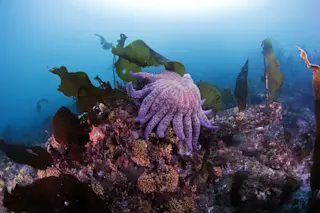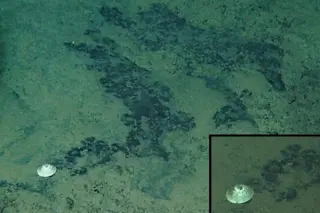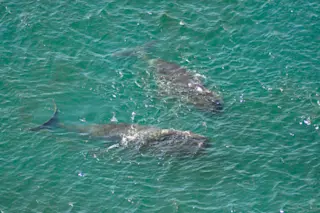Vernon, California, is a gritty industrial city about five miles southeast of downtown Los Angeles, its humble skyline dominated by wholesale food distributors, meat-processing plants, and assorted warehouses. One of those sprawling buildings is the unlikely home of the Natural History Museum of Los Angeles County Marine Mammal Laboratory-- 16,000 square feet of floor space on an obscure street, with no sign to mark the entrance to the small parking lot. On most days it would probably be very difficult to find. On this day, however, two frozen dolphin carcasses, sitting outside on the pavement near a loading dock, give the lab away.
Beyond the loading dock is a treasure trove of mammals, many of which never ventured anywhere near the sea. Despite its name, the Marine Mammal Lab is also the storage facility for the Natural History Museum’s collection of large land-mammal skeletons. Cabinets overflow with bighorn sheep skulls, plastic-wrapped deer antlers, mounted skeletons of primates and dogs--some 95,000 specimens in all. But the lab’s real treasures are the ones that give it its nickname: the whale warehouse. Sitting on shelves are skulls of exotic narwhals, each with its single long, twisted tusk; dolphin skulls and skeletons are scattered everywhere; and hundreds of other bones fill row after row of wooden and metal cabinets. On top of the cabinets are giant whale vertebrae, each a few feet across and weighing 50 to 60 pounds. Enormous bones, including the two-ton, 19-foot-long skull of a blue whale, lie propped on racks and against walls. A smaller room off the main warehouse holds hundreds of jars filled with the animals’ internal organs. Other jars hold their stomach contents. In all, the lab houses some 2,500 whale and dolphin specimens, plus another 600 seals and sea lions, making its collection of marine mammals second in size only to that of the Smithsonian.
The frozen dolphins near the loading dock had been removed from the tractor-trailer-size freezer in the parking lot for the benefit of a photographer. One of the dolphins, a calf, had come to the lab the previous spring, a victim of a still-unexplained die-off along the coast of central California. (Seventy to 80 dolphins and 3 sperm whales died in that episode; the whales and 20 of the dolphins were taken to the lab for study.) The other dolphin, an adult, had stranded itself on a local beach and had been recovered by the lab. In an average year, the lab might get two dozen dolphins and an occasional whale from area beaches. Another 40 to 60 marine mammals are received each year from commercial fisheries that find the animals drowned in their large nets. All are eventually dissected, then stripped of their flesh by an industrial steam cleaner or by the carnivorous dermestid beetle larvae that live in a temperature- and humidity-controlled cargo container next to the freezer. The remains are then added to the lab’s collection for storage and study.
John Heyning, the head of the museum’s marine mammal program and one of the lab’s two permanent staff members, has been recovering stranded marine mammals for nearly two decades. The dolphins, he says, are easy: adults usually weigh no more than 200 pounds, so most of the time it takes just one or two people to put the bodies into the back of a pickup truck. But sometimes the work is more grueling, and gruesome. In the early spring, Heyning spent a long day at Venice Beach recovering the remains of a humpback whale--a rarity as strandings go. The whale had apparently been accidentally rammed and killed by a Navy destroyer. The body was far too large to move--adult humpbacks can weigh up to 60 tons--so the recovery team decided to take just the head, which, pound for pound, would give them the most information about the animal’s life. After cutting through skin, blubber, and muscle with sickle-like Japanese flensing knives, they hoisted the severed head onto the back of a flatbed truck and transported it to the warehouse to be cleaned and analyzed; the rest of the carcass was buried on the beach.
Whales are not easy animals to observe, so such specimens frequently provide clues about the living animal that are otherwise hard to obtain. Recently, for example, Heyning pieced together the strange feeding mechanism of the Ziphiidae, or beaked whales, by studying a number of specimens at the lab, including a head that had been flown in from Johnston Atoll in the Pacific. Although classified as toothed whales, nearly all species of beaked whale in fact have very few teeth. Adult males usually have just a single tusklike pair, and females and juveniles have none at all. Researchers think that males use their teeth only to fight other males. That raises an obvious question: How do the whales eat?
With the help, it seems, of some very unusual physiology. Heyning and Smithsonian marine biologist James Mead found that the tongue of a beaked whale acts like a piston, operated by muscles that extend far back into the throat and chest. Coupled with this unusual tongue are grooves and muscles that allow the throat to expand. All this specialized anatomy allows the whale to suck its prey--usually squid--out of the water like a giant vacuum cleaner.
For the past few years Heyning’s work has also focused on a more mundane marine denizen, the common dolphin. More than 40 species of dolphin inhabit the world’s oceans and rivers. Some, like the almost totally blind Ganges river dolphin, are quite rare. Others, like the perpetually grinning bottle-nosed dolphin (Flipper, for example), are familiar to all of us. The common dolphin, Delphinus delphis, is just what its name implies. It lives around the world, from the coastal waters of the Pacific off California and Japan to the Black and Mediterranean Seas. During the past million years or so, the common dolphin has evolved into many varieties, each adapted to its own particular habitat.
Those varieties fall into two general types: short-beaked and long-beaked. Back in the late 1800s, some marine mammalogists decided that the two were actually different species and named the long-beaked dolphin Delphinus capensis (after the Cape of Good Hope, where the first specimen was found). But by the 1960s it was generally agreed that, despite their differences, the two types were indeed one species.
Heyning and William Perrin, a marine biologist at the Southwest Fisheries Science Center in La Jolla, studied the bodies and skeletons of 320 common dolphins that had lived off the coast of southern California. Aside from the obvious physical differences--the long-beaked dolphins have significantly longer snouts than their short-beaked counterparts and tend to have more muted coloration--Heyning and Perrin found a whole suite of more subtle distinguishing characteristics. All long-beaked dolphins tend to have more teeth and vertebrae than their short-beaked kin; short-beaked dolphins have longer flippers, taller dorsal fins, and larger flukes.
The animals also have different diets. An analysis of stomach contents showed that long-beaked dolphins eat quite a bit more squid than short-beaked dolphins, which prefer small schooling fish like anchovies. Their dining preferences may explain why short-beaked dolphins are often infested with a tapeworm known as Phyllobothrium, while long-beaked dolphins show low levels of the parasite.
Since the animals have long coexisted in the same waters, Heyning says, it’s not likely that their differences can be attributed to any difference in environment. They seem rather to have diverged genetically. Late last year Heyning and his colleagues published a study of two mitochondrial DNA sequences in 29 short- and long-beaked dolphins. Both sequences, the researchers found, differed significantly between the two dolphin types. In fact, short-beaked dolphins from southern California were 50 times more closely related to their short-beaked cousins from the Black Sea and South America than they were to southern California long-beaked dolphins. That means there is no gene flow, Heyning says. They aren’t reproducing with each other even though they are living in the same body of water.
At first blush, whether there is one or two species of common dolphin seems a purely academic issue. Neither species, after all, is endangered. Yet each year thousands of these dolphins are accidentally killed by fisheries worldwide. Except in California, which recently changed its record-keeping requirements because of Heyning’s work, no one bothers to note which form the killed dolphins belong to. In some regions, Heyning fears, these kills could bring about the inadvertent disappearance of one or the other species. If a large number of only one kind is being killed, you could deplete one species and not know it, Heyning says. I’m hoping that because of this study people will take a more careful look at the common dolphins in their region and then start managing and assessing the animals based on what they really have, and not by lumping them all together.
To a scientist, it’s research like this that makes the Marine Mammal Lab’s collection so important. A guest can easily be overwhelmed by the lab itself--the frozen bodies in the parking lot, the beetle-scoured skulls and skeletons, the smell--but the whale warehouse is much more than that. It provides us with unique insights into the lives of whales and dolphins, says Heyning, glimpses that we wouldn’t get by observing them at sea. And it not only increases our knowledge of these animals but helps us conserve them and lets us know more of the environment that we all share.














